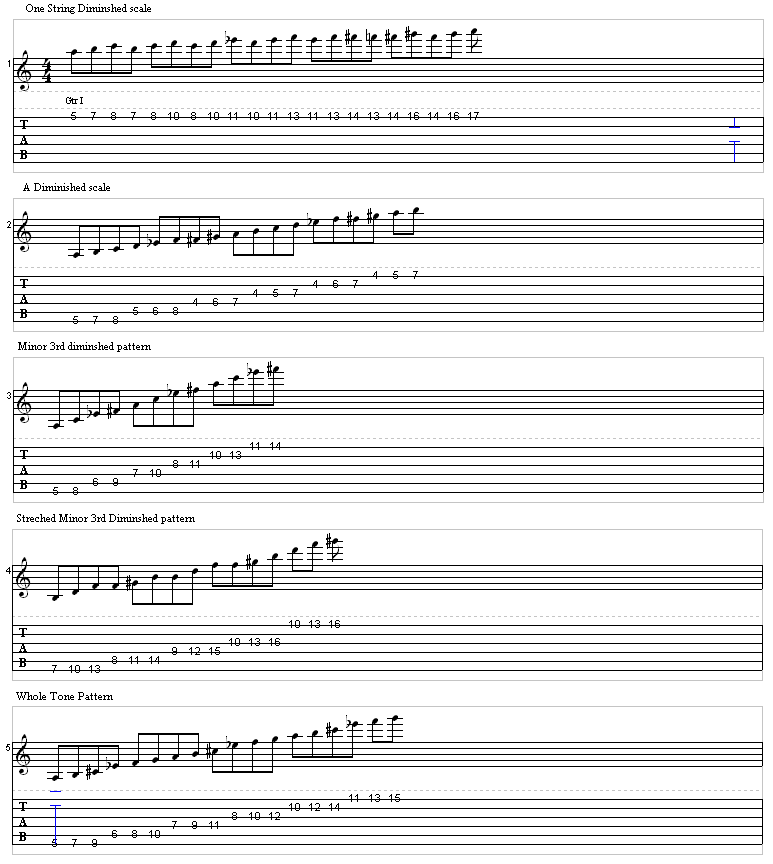Of all of the underused scales in rock n' roll; the symmetrical scale has to be at the top of the list. Rockers, it is time we get hip to what our hipster cousins in the world of progressive jazz have known about for some time. If you dig outside rock and metal like Buckethead and Primus, as well as more esoteric Satch you will find a lot to like here.
So what exactly is a symmetrical scale anyway? The primary characteristic of a symmetrical scale is that it doesn't rely on scale steps for its construction but on a symmetrical pattern. In other words you would not achieve a diminished scale by lowering the 3rd or the 7th, but by using a series of half steps and whole steps. In fact the formula that makes up a diminished scale is indeed whole step-half step. This means that if you start on a note and go whole step-half step on for forever you have a diminished scale. This can be done cross string where you cover every string top to bottom, or even on a single string. The use of a pattern makes these shapes very easy to learn and use. Another common way to use diminished tonalities is to build what in essence is a very long diminished arpeggio and string it across the neck so that it appears to be a scale. In the tab I have included a shape that ascends across the neck by moving a minor 3rd pattern up in tritones. What you get is a pattern where every note is a minor third away from every other note. If you stretch it out to include two minor thirds on one string you get something that is wicked cool. It too moves up in tritones but the wide intervals make it sound like you are going at light speed even when you are playing at a rather moderate tempo. Add tapping to this by tapping up an additional minor third, and in the words of Leonidas, "Prepare for Glory"!
The other symmetrical scale I want to cover in this article is the whole tone scale. This is a scale that is shockingly built entirely of whole steps. Basically string together an endless string of whole steps and bam; you just built yourself a whole tone scale. I have included in the tab one example that does three notes per string and crosses the neck, and one pattern that stays in the same position. My suggestion is to learn both shapes to be as well rounded as possible. So that brings us to the big question which is how to apply these scales.
As is the case with many scales there are many ways to use these symmetrical patterns. In the case of diminished scales they can be used over diminished and half-diminished chords, or over Locrian power chord progressions. To go with more of an outside perspective you can also apply these to altered dominant chords (i.e. E7 #9/b9, D9b5, etc.). In the case of the whole tone scale, it can be applied to augmented chords. It can also be used over altered dominant chords (particularly Dom7 #5 chords). One highly underrated use of the whole tone scale is as the basis for riff playing. It is particularly effective when paired with an odd time signature in this capacity. No really try it, its insanely cool.
Well, here's hoping that you know a whole lot more than you did before you read this article about the wonderful world of symmetrical scales. If there's one thing I hope to accomplish with this series, it's to alleviate some ignorance (especially in rock and metal circles) of some techniques used by killer guitarists outside of our genre. Just because these scales are mainly used by jazzers doesn't mean that these aren't cool ideas. It's just up to us to make them rock!

Good luck!
Scott Allen is a 1996 graduate of the Musician's Institute, G.I.T. He currently teaches guitar to 65 to 70 students weekly at Northridge Music Center.
His latest CD is entitled "III", featuring his impressively fluid playing, with a style marked by an incendiary sense of phrasing.